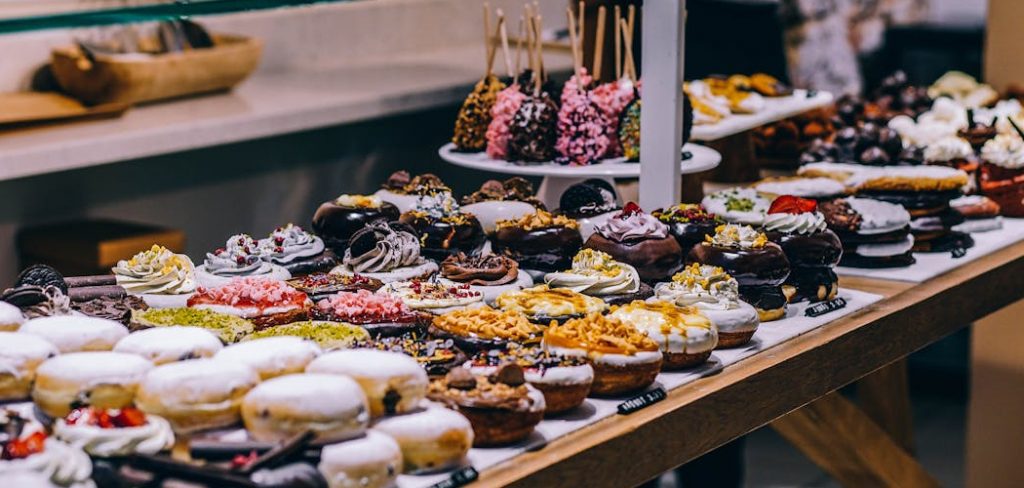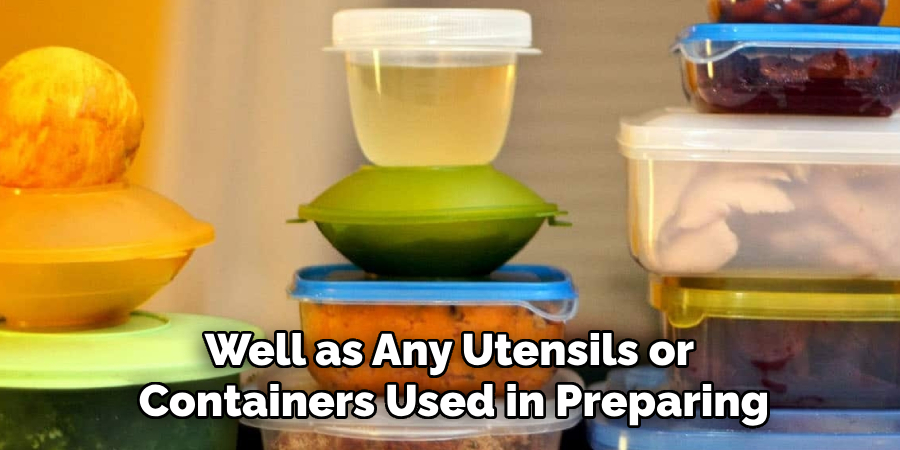Are you tired of throwing away leftover glaze after every cake or pastry project? Do you want to find a way to store it and use it for future recipes? You’re in luck! In this guide, we’ll take you through some simple steps on how to store leftover glaze.

It’s common to have leftovers when working with glazes, whether for pottery, baked goods, or other creative projects. Properly storing leftover glaze is crucial to maintain its quality and usability for future use. Without the proper storage techniques, the glaze may dry out, become contaminated, or lose its consistency.
Following a few simple steps, you can ensure that your leftover glaze stays in optimal condition, ready to be used when inspiration strikes again.
What Are the Benefits of Storing Leftover Glaze?
Before we dive into the storage techniques, let’s first understand why it’s essential to store leftover glaze properly.
- Cost-effective: By storing and reusing leftover glaze, you avoid wastage and save money in the long run.
- Time-saving: Having pre-made glazes ready can save you time when working on future projects.
- Consistency: Properly stored leftover glaze will maintain its consistency, making it easier for you to achieve desired results in your next project.
Now that we’ve established the benefits, let’s look at different ways to store leftover glaze.
What Will You Need?
- Airtight containers: These are essential for storing glaze, as they prevent air from getting in and drying it out.
- Labels: It’s essential to label your containers with the type of glaze, date stored, and expiry date (if applicable).
- Spoons or spatulas: Use clean utensils when handling leftover glaze to avoid contamination.
Once you have all the necessary items, let’s move on to the storage techniques.
10 Easy Steps on How to Store Leftover Glaze
Step 1. Allow the Glaze to Cool
Before storing leftover glaze, ensure it has completely cooled to room temperature. Storing warm or hot glaze can cause condensation inside the container, which may dilute the glaze or lead to potential bacterial growth. To speed up the cooling process, place the glaze in a shallow dish and allow it to sit uncovered in a calm, dry environment. Avoid placing it directly in the refrigerator while still warm, as this can alter the glaze’s texture. Thorough cooling ensures the quality and consistency of the glaze remain intact for future use.

Step 2. Choose the Right Storage Container
Select an airtight container to store your leftover glaze. Glass or food-safe plastic containers with tight-fitting lids work best to ensure no air enters, which could cause the glaze to dry out or spoil. Avoid using containers that are too large for the amount of glaze, as excess space may lead to oxidation. For best results, match the container’s size to the glaze volume to minimize air exposure. If needed, consider using smaller jars or compartments for portioned storage.
Step 3. Label and Date Your Container
To keep track of freshness, it’s essential to label your storage container with the type of glaze and the date it was prepared. This practice helps you monitor how long the glaze has been stored and ensures it is used before it loses its quality. Use a waterproof marker or sticky label to record this information. Proper labeling is especially useful if storing multiple types of glazes or preparing them for future use.
Step 4. Store in the Right Environment
Proper storage conditions are key to maintaining the quality of your glaze. Keep the container in a cool, dry place, away from direct sunlight or heat sources, as excessive warmth can alter the glaze’s consistency or cause it to spoil prematurely. Refrigeration can help extend freshness for longer storage periods, especially for glazes containing perishable ingredients. However, always ensure the glaze is brought to room temperature and stirred well before use to regain its ideal texture and consistency.

Step 5. Test the Glaze Before Use
Before applying the glaze to your dish, it must be tested to ensure it retains the desired flavor, texture, and consistency. Stir the glaze thoroughly to prevent any separation of ingredients, and taste a small sample. If adjustments are needed, such as adding a spice or sweetness, or thinning the glaze with a splash of liquid, make these changes before using it on your final dish. Testing helps ensure the glaze enhances your recipe and avoids any last-minute surprises.
Step 6. Apply the Glaze Evenly
When it’s time to apply the glaze, do so evenly for a smooth and appealing finish. Using a brush, spoon, or other appropriate tools, coat the surface of your dish with thin, consistent layers of glaze. For best results, apply the glaze in stages—allowing each layer to set slightly before adding the next. This method creates a glossy, professional appearance and ensures the flavors penetrate the dish evenly. Remember to monitor your dish closely, especially in baking or grilling scenarios, as the glaze could caramelize or burn if exposed to excessive heat for too long. Adjust cooking times as needed to achieve the perfect result.
Step 7. Serve and Enjoy
Once your dish is glazed and perfectly cooked, it’s time to serve and enjoy the fruits of your labor. Carefully transfer your creation to a serving platter, preserving the glaze’s presentation and glossy finish. Consider garnishing your dish with complementary herbs, spices, or sides to enhance its visual appeal and flavor profile. Whether it’s a centerpiece for a special occasion or a casual meal, your glazed dish will impress and delight everyone at the table.

Step 8. Clean Up and Store Leftovers
After enjoying your meal, cleaning up and properly storing any leftovers is essential to maintain freshness. Begin by clearing the table and washing any utensils, dishes, or cookware used in the preparation and serving process. If there are any remaining portions of your glazed dish, transfer them into airtight containers and refrigerate promptly. Proper storage helps preserve the flavors and ensures the dish stays safe to consume later. When reheating, consider using methods that retain the glaze’s texture, such as gentle heating in an oven or stovetop rather than a microwave.
Step 9. Check the Expiry Date
While most glazes can last several weeks or even months, it’s important to check the expiry date before using them. If stored correctly in a cool environment with minimal air exposure, most types of glaze will remain fresh and safe to use well beyond their best-by date. However, if there are any signs of spoilage or off-flavors, discard the glaze immediately to avoid any potential foodborne illnesses.
Step 10. Practice Safe Food Handling
Finally, following safe food handling practices is essential when storing leftover glaze. Always wash your hands thoroughly before and after handling food, as well as any utensils or containers used in preparing and storing the glaze. Additionally, ensure all surfaces and tools are clean and sanitized to prevent cross-contamination. If in doubt, err on caution and discard any questionable or potentially spoiled glaze to avoid potential health risks.

By following these steps, you can ensure your leftover glaze stays fresh and safe for future meals.
5 Things You Should Avoid
- Failing to Use Airtight Containers: Avoid storing glaze in containers that are not airtight. Exposure to air can cause the glaze to dry out or spoil more quickly, impacting its texture and flavor.
- Leaving the Glaze at Room Temperature for Too Long: Never leave leftover glaze at room temperature for extended periods. Bacteria can proliferate in these conditions, making consuming the glaze unsafe.
- Using Dirty Utensils or Containers: Always ensure that the utensils and containers used for storing glaze are clean. Contaminants from dirty tools can spoil the glaze and pose a health risk.
- Overlooking Labeling and Dating: Do not forget to label and date the container. Without proper labeling, it’s easy to lose track of how long the glaze has been stored, which increases the risk of using spoiled leftovers.
- Storing Near Strong-Smelling Foods: Avoid placing the glaze near foods with strong odors in the refrigerator. Glaze can absorb these smells, which may alter its taste and make it unappetizing for future use.
By avoiding these common mistakes, you can ensure your leftover glaze stays fresh and safe for future meals.
Conclusion
Storing leftover glaze properly is essential to maintaining its quality and ensuring it remains safe.
You can significantly extend its shelf life by following simple guidelines such as refrigerating it promptly, using clean storage containers, and labeling it with a date. Avoid common mistakes like leaving it at room temperature for too long or storing it near strong-smelling foods, as these can compromise the glaze’s taste and safety. Proper storage practices allow you to enjoy your delicious glaze without worrying about your next meal.
Hopefully, the article on how to store leftover glaze has provided you with helpful tips and information on preserving the flavor and safety of your glaze. So, don’t be afraid to get creative in the kitchen and try new techniques with your glazed leftovers. Bon appétit!
